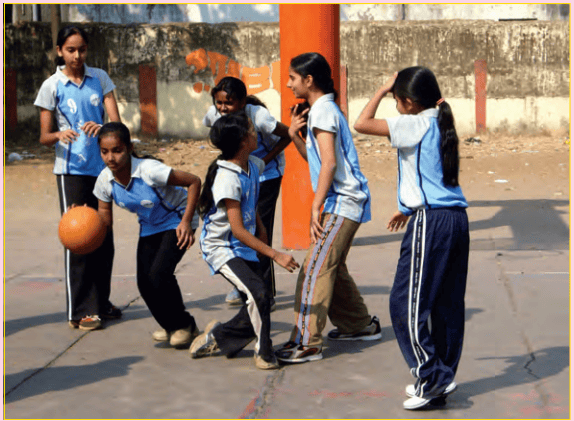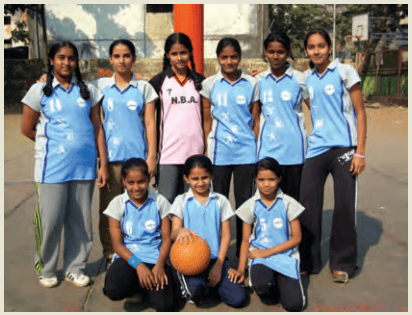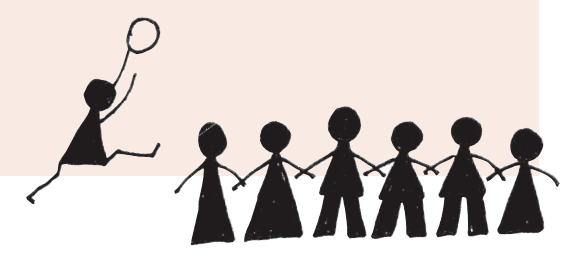HOTS Questions: Across the Wall | EVS Class 5 PDF Download
Q.1. What motivated Zarin to play basketball?
(A) The fear of losing to boys
(B) Watching her brother play and wanting to show her talent
(C) Peer pressure from friends
(D) A desire to win trophies
Answer: (B) Watching her brother play and wanting to show her talent
 View Answer
View Answer 
Solution: Zarin felt inspired to show her talent after watching her brother play basketball, she wanted to join in and play too.

Q.2. What challenge did Afsana face from her mother regarding playing basketball?
(A) She wanted Afsana to join a different sport.
(B) She encouraged Afsana to play only with boys.
(C) She initially disapproved of Afsana playing basketball.
(D) She did not want Afsana to play sports at all.
Answer: (C) She initially disapproved of Afsana playing basketball.
 View Answer
View Answer 
Solution: Afsana's mother was initially against her playing basketball due to concerns about societal perceptions and norms.
Q.3. How did the girls feel about their participation in the basketball team?
(A) They were indifferent and did not care about winning.
(B) They believed it was only a temporary activity.
(C) They felt empowered and supported by each other.
(D) They were afraid of being judged by others.
Answer: (C) They felt empowered and supported by each other.
 View Answer
View Answer 
Soluton: The girls experienced a sense of empowerment and camaraderie through their participation in the basketball team, encouraging one another throughout their journey.
Q.4. Afsana and her team aspire to play for their country and aim to win a ___________ medal.
Answer: Gold
 View Answer
View Answer 
Solution: Afsana and her team want to represent their country and win a gold medal. This shows their strong desire to succeed and the hard work they put into basketball.
Q.5. During their match in Sholapur, the Nagpada team faced challenges with the local team, who treated them as ___________.
Answer: Juniors
 View Answer
View Answer 
Solution: The local Sholapur team did not respect the girls from Nagpada and looked down on them. This highlights the need for equal treatment and respect among all players in sports.

Q.6. How did Afsana's story reflect the challenges faced by girls in pursuing sports?
Answer:
- Afsana’s story shows obstacles stopping girls from playing sports.
- She faced her mother’s initial opposition to playing.
- Cultural beliefs can limit girls' participation in activities seen as for boys.
- Afsana's success highlights the importance of hard work and support from friends and coaches.
Q.7. What role did the coach play in the development of the Nagpada Basketball Association?
Answer:
- The coach provided mentorship and taught the girls skills.
- He encouraged them to form a team, empowering them to challenge societal norms.
- His belief in the girls boosted their confidence and helped them gain recognition in competitions.

Q.8. Discuss the impact of family support on the girls’ decision to play basketball.
Answer:
- Family support differed; some girls encountered initial resistance.
- Afsana’s mother changed her mind after discussions, showing the power of communication.
- Khushnoor’s father supported her ambitions, illustrating how encouragement inspires young athletes.
Q.9. In what ways do the girls’ experiences challenge traditional gender roles in sports?
Answer:
- The girls participate in basketball, a sport traditionally associated with boys, proving that skills are not gender-specific.
- Their success undermines societal norms regarding suitable activities for girls.
- Their determination and unity send a strong message against gender discrimination in sports.
Q.10 Analyze the significance of teamwork as depicted in the story.
Answer:
- Teamwork is essential for success, focusing on collective efforts rather than individual accomplishments.
- The girls support each other, fostering a sense of community during practices and competitions.
Understanding each other's capabilities emphasizes the importance of cooperation in achieving success.

Q.11 What lessons can be learned from Afsana’s journey regarding perseverance and determination?
Answer:
- Overcoming Obstacles: Afsana's journey teaches that strong determination and hard work are crucial for overcoming challenges.
- Inspiration: Her persistence in the face of pressures serves as an inspiration for others.
- Goal Setting: The journey highlights the importance of setting goals and striving to achieve them despite difficulties.
Q.12. Reflect on the societal implications of the girls’ basketball team gaining acceptance in the community.
Answer:
- Changing Attitudes: Acceptance of the girls’ team reflects shifting societal attitudes toward female athletes.
- Promoting Equality: It promotes gender equality by recognizing women's contributions in sports.
- Inspiration for Others: Their success may motivate other girls to pursue their interests, breaking down societal barriers.
Q.13. What strategies did the girls use to overcome obstacles in their journey?
Answer:
- They talked with family members to explain their passion for basketball, leading to better understanding.
- The girls built a supportive network, encouraging each other and sharing experiences.
- They practiced diligently under the coach’s guidance, improving their skills and confidence.

Q.14. How does the chapter highlight the theme of empowerment through sports?
Answer:
- The chapter shows that participation in sports empowers girls, boosting their self-esteem and confidence.
- It provides a platform for them to express themselves and challenge gender stereotypes.
- The success of the Nagpada team serves as hope for other girls, showing they can achieve their dreams through sports.
Q.15. Discuss the importance of sports in fostering unity and cooperation among the girls.
Answer:
- Sense of Belonging: Sports create a strong sense of friendship and belonging among the girls.
- Strengthening Bonds: Facing challenges together fosters mutual respect and strengthens their relationships.
- Enhanced Teamwork: Unity in sports leads to better teamwork, improving both performance and enjoyment of the game.
|
37 videos|410 docs|41 tests
|
FAQs on HOTS Questions: Across the Wall - EVS Class 5
| 1. What is the main theme of "Across the Wall"? |  |
| 2. Who are the key characters in "Across the Wall"? |  |
| 3. What lessons can be learned from "Across the Wall"? |  |
| 4. How does the author use symbolism in "Across the Wall"? |  |
| 5. Why is "Across the Wall" relevant to today's readers? |  |
















